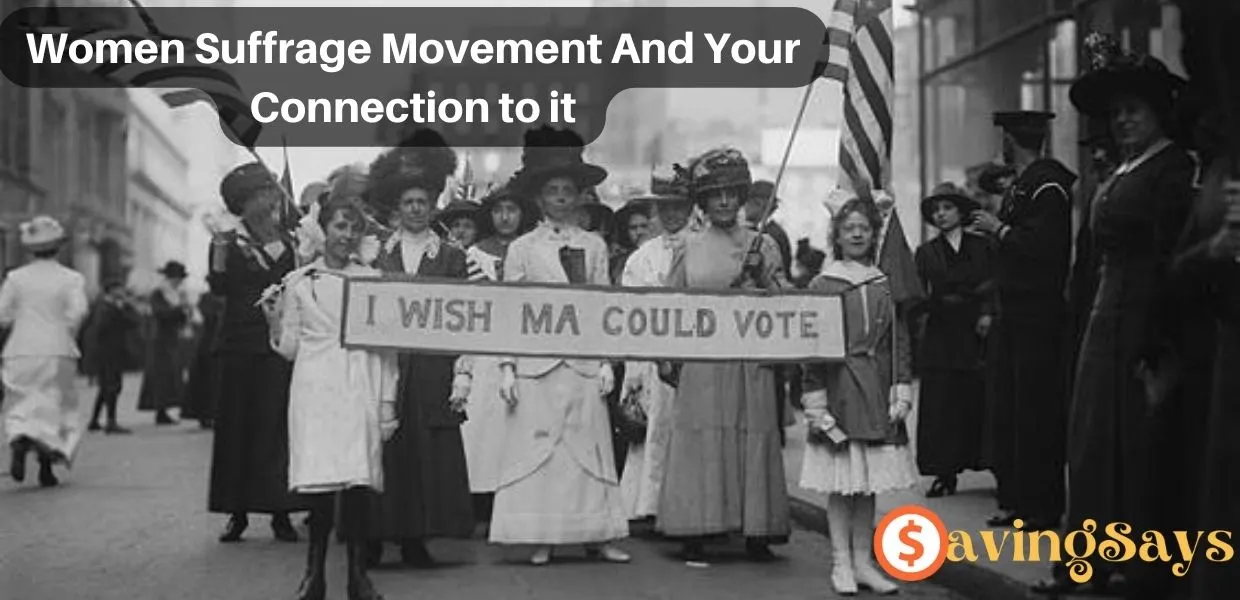
Women Suffrage Movement And Your Connection To It
Posted on |
Women have never found it easy to survive in this patriarchal world and have had to continuously fight for their rights. Although one might argue that women today have it easier than those who lived during the 1900s. But this has only been possible due to the continuous and rigorous efforts of women activists and historians who worked their entire lives to make this world a better place for women. There have been quite a few women-led political and social movements throughout history that have focused on securing more rights for women. One such instance was the women’s suffrage movement which focused on securing voting rights for women.
Women’s Suffrage Movement
In the early 1800s, women didn’t have many rights. People in charge discouraged women from getting an education. Women were not allowed to do jobs, nor could they own property and they weren’t allowed to vote either. It wasn’t until the mid-1800s that women started to fight back, demanding more equality and the right to vote. The group of women who led this fight named it the women’s suffrage movement while the members were called ‘suffragists’.
When did it begin?
The first roots of the movement were put in when Elizabeth Cady Stanton and Lucretia Mott organized the first convention regarding women’s rights in 1948. This event was attended by over 300 people. Such conventions were held numerous times in the upcoming years however it wasn’t until 1890 that the National American Woman Suffrage Association (NAWSA) was officially formed.
Why was it formed?
The movement’s main purpose was to secure equal voting rights for women using a Congressional amendment to the Constitution. Although before NAWSA was officially formed, disagreements over strategy threatened to cripple the movement more than once. But with true determination and hard work, the members of the Suffrage Movement finally achieved their goal in 1920.
What did it achieve?
The federal woman suffrage amendment, originally written by Susan B. Anthony and introduced in Congress in 1878, was passed by the House of Representatives and the Senate in 1919. It was then sent to the states for ratification. The decades-long fight to win the right to vote for women in the United States finally came to an end when Tennessee became the 36th state to ratify the amendment on 18 august 1920. This was made official 8 days later when the 19th Amendment to the Constitution was ratified, granting women the right to vote for the first time in the history of the United States of America.
Your Connection To The Suffrage Movement
You would be surprised to find out that you are related to some of the most important women in history. Women who played a really important part in the suffrage movement. But how can somebody find out for sure if they are related to these really important female figures? Well, there are several ways in which you can find out about your ancestors. These include:
- A DNA Test
- A Well Researched Family Tree
However, you will need professionals for both of the things mentioned above. But don’t worry, we’ve got a solution for that, Ancestry. A DNA testing service that analyzes your DNA and integrates that data with your family tree. Ancestry can help you, uncover your family history and find out about your ancestors who lived during the 1900s. Ancestry will provide you with exact information regarding who your ancestors were, what they did, and what role they played in the suffrage movement. With access to over 30 million records from over 80+ countries. You would be able to find out exactly how much did your ancestors contribute to this world-changing movement. The results will make you appreciate the hardships your ancestors went through to give you the comfortable and free life that you live today.
Services at Ancestry
Save Money At Ancestry
So if you ever consider getting a DNA test or making a Family Tree at Ancestry but don’t want to spend a fortune on it. You can always find coupons and deals on Saving Says. Feel free to check out Ancestry coupons and deals at Saving Says:
10% OFF
10% Off Sitewide
10% Off Sitewide At Ancestry.


10% Off Sitewide
10% Off Sitewide At Ancestry.
UP TO $60 OFF

Learn More About Suffrage Movement With Ancestry
Ancestry has over 7+ articles that focus on the events that occurred during the women’s suffrage movement. Some of these articles focus on events that led up to the 19th amendment being finally ratified while others focus on the hardships suffered by the members of the movement. Feel free to check out some of these articles listed below.:
- How African American Women Mobilized for Voting Rights
This article focused on the struggles of black women who not only faced discrimination due to gender but also due to their race. This discrimination came not only from the men but also from women who were a part of the suffrage movement. Black women were often left out of conventions organized by the movement leaders.
- The path to 36: Ratifying the 19th Amendment
When congress passed the 19th amendment on June 4, 1919, it was only a small win in the fight to get complete voting rights for women because now the movement had to get the vote of three-fourths of the then 48 state legislatures to ratify this amendment. This article focuses on difficulties faced by the movement to get the 36 states to pass the amendment. Furthermore, this article explains how the advice of a mother changed the course of American history and helped the movement achieve its main goal.
Other Articles include
- Making Them Count: The Continuing Path to Voting Equality
- Through the Cracks of the 15th and 19th Amendments
- Votes for Women: Who Could and Couldn’t in Your Family History
Conclusion
People of our era will never be able to fully understand the efforts of our ancestors. These efforts include the sheer resilience and determination shown by the members of the Women’s Suffrage Movement. However, one could get an idea of the struggles of the Suffragists by reading about the movement and the events surrounding them. Furthermore, one can feel more connected to the movement if some of their ancestors took an active part in it. And to find out about your ancestors you can use Ancestry DNA kits or use their family tree service. This will help you understand your ancestor’s efforts and thus your connection to the Women’s Suffrage Movement.
